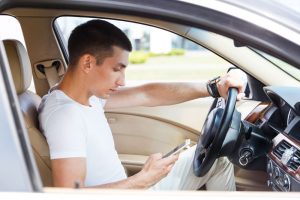 Whether it’s applying makeup, eating a meal, fiddling with the A/C or trying to find your playlist, distracted driving is common. It’s also very dangerous, and mostly avoidable.
Whether it’s applying makeup, eating a meal, fiddling with the A/C or trying to find your playlist, distracted driving is common. It’s also very dangerous, and mostly avoidable.
According to the National Highway Traffic Safety Administration (NHTSA), distracted driving killed 3,477 people in 2015, and was the cause of 391,000 injuries. Teens were reported as being the largest age group of distracted drivers at the time of fatal crashes.
Approximately 660,000 drivers are using cell phones while driving during daylight hours, creating an enormous risk for death and injuries on the road. As a rule, if you cannot devote your full attention to driving, then it’s a distraction. You can take charge of eliminating distractions by doing the following:
- Avoid phone calls and text messages. Your smartphone has many cool features, but that phone call and text message can wait when you’re behind the wheel. Even with hands-free devices, you can still miss important audio and visual cues while driving. The NHTSA says texting is the most alarming distraction. It takes about 5 seconds to send a text, which at 55 mph is like driving the length of a football field with your eyes closed. Enable the ‘car mode’ on your phone to disable notifications and will send a message to people letting them know you’re driving.
- Don’t multitask behind the wheel. It’s tempting to answer that text or reprogram your GPS after it has recalculated directions but resist the temptation. Program your directions, select your playlist and get your EZ Pass or toll money ready before you take off. Be organized and focus on the road ahead so you can react to the unexpected. Take care of that work email or call your friend before or after your trip, not behind the wheel. In summary, get everything settled before you start driving.
- Enlist the help of passengers. More passengers can mean greater risk, especially if the driver is new to the road. Combat extra commotion by having everyone keep their voices down, keeping music to a moderate level and paying attention to what’s happening on the road. If you have passengers in the car, enlist their help to be an extra set of eyes and hands. Their hands are free to run the GPS or send a text for you.
- Snack smart. Eat meals before or after your trip. Finishing breakfast on the way to work or scarfing down a burger on the way to soccer practice may seem like a time-saver, but it means you’re less attentive to the drivers around you. Food and drink spills get messy and become a major cause of distraction.
- Limit activity in the car. Store loose gear and items in a location where they won’t roll around. Secure children and pets before going on the road. If they need your attention, don’t reach into the backseat. Safely pull over to the side of the road.
Distracted driving didn’t start when cell phones were introduced but technological leaps are increasing the dangers of driving. Fully focus on driving and pay attention to the rules of the road. Any non-driving activity is a potential distraction and increases your risk of crashing. Take your time driving to keep yourself and passengers safe on the road.



